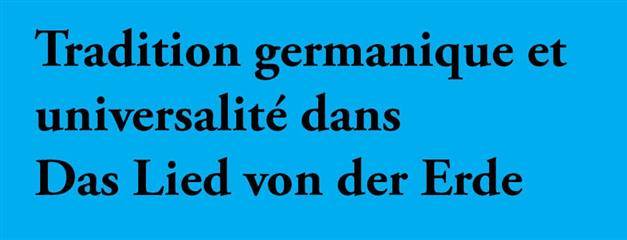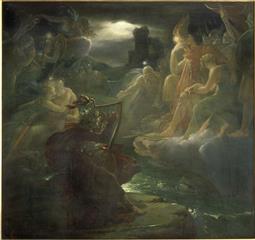Revue Musicorum

D'un lied à l'autre ?


During European Romanticism, the rediscovery, representation, and dissemination of folklore and ancient popular songs challenged the prevalent literary and musical models inherited from Classicism and sustained claims for recognition of the minority languages that were carriers of these songs. This article shows how the portrayal of Flemish folk songs during the long 19th century fitted the growing call for valuing, studying and spreading the Flemish language and its literary patrimony. It presents the major anthologies issued during that period and surveys a wide variety of transfer techniques, including translation, by which networks of mediators attempted to promote old Flemish poetry and music in Belgium, Germany and France.
Lieven D'hulst


Song anthologies have a long tradition. After a short overview of the main French and German examples of the 18th century, so as to display the antecedents of the different sorts of song anthologies (profane, spiritual, folksong, national or international repertoire, get-up with illustrations, reproduction of the melodies in musical notation), the present comparison focuses on two examples of French anthologies of the 19th century: Chants et chansons populaires de la France (Delloye, 1843), and Dumersan’s and Ségur’s Chansons nationales et populaires de France (1845), then on two German anthologies from the same period: Finks Musikalischer Hausschatz der Deutschen (1843) and Härtel’s Deutsches Liederlexikon (1865).
Delloyes has the special prospect of submitting historical French “myths” and specific contemporary stories, musical notation of melodies with first class lithographs. The collection by Dumersan-Ségur belongs to the tradition of parody chansons, sung on “timbres”, but contains also an important choice of contemporary romances. Fink’s Hausschatz presents a choice of authentical folksongs and popular compositions especially by composers of the two Berlin “song-schools”, presented in eleven different categories. Härtel modernizes the repertory moderately. The comparison of classifications in those national anthologies illustrates national peculiarities and cultural differences.
Herbert Schneider


The French literary movement of symbolism was transfered to Germany by poets like Richard Dehmel and Stefan George, who translated and transformed poems of Verlaine and Baudelaire and wrote poetry in symbolistic manner. Composers like Richard Strauss, Max Reger, Alexander Zemlinsky, Conrad Ansorge, Arnold Schönberg, Anton Webern and many others set these texts to music. The article reveals the influence of symbolism in the poetry of Dehmel and George and analyzes how this esoteric style is set to music in different ways in selected ›lieder‹ of Strauss, Webern and Ansorge.
Elisabeth Schmierer


Alexander Zemlinsky composes lieder on an amazing wide range of poetical sources. These sources are from varied geographical, historical or aesthetic origins: Tuscan popular texts, (Walzer-Gesänge nach Toskanischen Liedern von Gregorovius, op. 6), Danish poet Jans Peter Jacobsen (Opus 7, 8 and 10), Symbolists Charles Baudelaire (Harmonie des Abends) and Maurice Maeterlinck (Sechs Gesänge, op. 13), Indian writers Rabindranath Tagore, Kalidasa and Amaru (Lyrische Symphonie, op. 18 and Zwölf Lieder, op. 27), Harlem Renaissance African-American writers Langston Hughes, Jean Toomer, Countee Cullen, Frank Smith Horne and Claude McKay (Symphonische Gesänge, op. 20 and Zwölf Lieder, op. 27). This article sheds light on Zemlinsky’s choices, then investigates their possible consequences on his compositional strategies and musical language.
Hélène Cao


The creation of The Song of the Earth (1908-1909) – a set of six songs (Lieder) with orchestra – marked a milestone in Gustav Mahler’s development as a composer. Until 1904 his approach of the song was largely inspired by the German tradition using texts from the famous collection Des Knaben Wunderhorn (The Boy’s Magic Horn). In 1907, strongly affected in his life by several dramatic events, Mahler turned to a collection of texts inspired by the Chinese poetry of the eighth century (The Chinese flute by Hans Bethge), and he organized his musical setting in a symphony-like form for large orchestra sung by two soloists, a tenor and a mezzo. Without giving in to the popular exoticism of the time during the Jugendstil era, Mahler makes use of Chinese poetic themes and music devices (pentatonic scale, sounds...) in order to escape from his tragedy as a man and artist. Mahler bases his songs on texts rewritten by Westerners and adapts them to his particular situation. He creates an inauthentic Chinese music to give an exotic varnish. The result is that these songs appear as an illusion intended to subtly express the disillusioned character of his inner thoughts. Apparently far from his usual source of inspiration, Mahler actually creates a pseudomorphous effect by reiterating, in The Song of the Earth, his permanent link with the German national tradition, but presented here under the guise of Chinese exoticism. This way of proceeding allows Mahler to create a chimeric atmosphere allowing him to tell the tragic of his existence while masking the reality of the events. It reflects his desire for transcendence and universality of the expressed emotions.
Jean-Jacques Velly


The two forms, lied and sonnet, met up and mingled in Germany in the second half of the nineteenth century. German poets’ anthologies often include lieder and sonnets, together or side by side. The lied and the sonnet look similar and their respective names have the same meaning. But in fact, they are very different and even opposite forms. The lied is described as a progressive form that can be subject to prolongation. On the contrary, Laure, the “lady” of the sonnet written and thought by Petrarch, cuts or incises any kind of sentence and melody. It thus undoes the diatonic hierarchy and gives way to what Deleuze and Guattari call a “generalized chromatism”. So, in some way, from the lied to the sonnet, everything changes. However, both forms communicate and answer one another. This is the point that will be explored by examining a lied that Schubert composed, inspired by Johann Diederich Gries’s German translation of Petrarch‘s Italian sonnet 164.

Philippe Marty

In the classical music community, the term “lied” is associated with narrow and highly specific programming practices and general usage largely focused on works from the long 19th century. But during that century, greater variety was common. In the scholarly community since the mid-19th century, the term has long been the source of unease, exemplified today by Danuser’s proposed abandonment of the term in the 2004 Handbuch der musikalischen Gattungen. This article traces various definitions and usages of the term lied over the course of the long 19th century, touching on the aesthetic values, practices and ideologies which have tacitly — and sometimes incongruently — shaped current understanding.

Chanda Vander Hart

In European music academies and conservatories, the lied repertoire stands out as one of the most important in the training of young singers and accompanists. As many of them do not come from a Germanophone background, their instruction is often carried out in an intercultural educational context. This contribution looks at the specificities of these situations, which partly determine the appropriate pedagogical methods. Beyond a satisfactory pronunciation and understanding of the text, the interpretation of this repertoire also depends on the historical, literary, aesthetic and cultural contexts that underly the work. If the construction of the interpretation of the piano-voice duo relies on traditions sometimes firmly rooted in the culture of the lied, the recognition of the dialectical relationship that dichotomizes poem and music in the lied - in the sense that Nicolas Ruwet, in particular, has been able to consider it - allows young performers to bring out the convergences between the two as tensions that may exist within the work, and give them ways to develop their own personal approach.


Jean-François Rouchon
Placez le curseur sur les flèches pour afficher les titres.